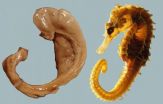(Press-News.org) The trope that the likelihood of an accurate group decision increases with the abundance of brains involved might not hold up when a collective faces a variety of factors — as often happens in life and nature. Instead, Princeton University researchers report that smaller groups actually tend to make more accurate decisions while larger assemblies may become excessively focused on only certain pieces of information.
The findings present a significant caveat to what is known about collective intelligence, or the "wisdom of crowds," wherein individual observations — even if imperfect — coalesces into a single, accurate group decision. A classic example of crowd wisdom is English statistician Sir Francis Galton's 1907 observation of a contest in which villagers attempted to guess the weight of an ox. Although not one of the 787 estimates was correct, the average of the guessed weights was a mere one-pound short of the animal's recorded heft. Along those lines, the consensus has been that group decisions are enhanced as more individuals have input.
But collective decision-making has rarely been tested under complex, "realistic" circumstances where information comes from multiple sources, the Princeton researchers report in the journal Proceedings of the Royal Society B. In these scenarios, crowd wisdom peaks early then becomes less accurate as more individuals become involved, explained senior author Iain Couzin, a professor of ecology and evolutionary biology.
"This is an extension of the wisdom-of-crowds theory that allows us to relax the assumption that being in big groups is always the best way to make a decision," Couzin said.
"It's a starting point that opens up the possibility of capturing collective decision-making in a more realistic environment," he said. "When we do see small groups of animals or organisms making decisions they are not necessarily compromising accuracy. They might actually do worse if more individuals were involved. I think that's the new insight."
Couzin and first author Albert Kao, a graduate student of ecology and evolutionary biology in Couzin's group, created a theoretical model in which a "group" had to decide between two potential food sources. The group's decision accuracy was determined by how well individuals could use two types of information: One that was known to all members of the group — known as correlated information — and another that was perceived by only some individuals, or uncorrelated information. The researchers found that the communal ability to pool both pieces of information into a correct, or accurate, decision was highest in a band of five to 20. After that, the accurate decision increasingly eluded the expanding group.
At work, Kao said, was the dynamic between correlated and uncorrelated cues. With more individuals, that which is known by all members comes to dominate the decision-making process. The uncorrelated information gets drowned out, even if individuals within the group are still well aware of it.
In smaller groups, on the other hand, the lesser-known cues nonetheless earn as much consideration as the more common information. This is due to the more random nature of small groups, which is known as "noise" and typically seen as an unwelcome distraction. Couzin and Kao, however, found that noise is surprisingly advantageous in these smaller arrangements.
"It's surprising that noise can enhance the collective decision," Kao said. "The typical assumption is that the larger the group, the greater the collective intelligence.
"We found that if you increase group size, you see the wisdom-of-crowds benefit, but if the group gets too large there is an over-reliance on high-correlation information," he said. "You would find yourself in a situation where the group uses that information to the point that it dominates the group's decision-making."
None of this is to suggest that large groups would benefit from axing members, Couzin said. The size threshold he and Kao found corresponds with the number of individuals making the decisions, not the size of the group overall. The researchers cite numerous studies — including many from Couzin's lab — showing that decisions in animal groups such as schools of fish can often fall to a select few members. Thusly, these organisms can exhibit highly coordinated movements despite vast numbers of individuals. (Such hierarchies could help animals realize a dual benefit of efficient decision-making and defense via strength-in-numbers, Kao said.)
"What's important is the number of individuals making the decision," Couzin said. "Just looking at group size per se is not necessarily relevant. It depends on the number of individuals making the decision."
INFORMATION:
The paper, "Decision accuracy in complex environments is often maximized by small group sizes," was published online April 23, 2014, by the Proceedings of the Royal Society B.
This work was supported by a National Science Foundation Graduate Research Fellowship, National Science Foundation Doctoral Dissertation Improvement (grant no. 1210029), the National Science Foundation (grant no. PHY-0848755), the Office of Naval Research Award (no. N00014-09-1-1074), the Human Frontier Science Project (grant no. RGP0065/2012), the Army Research Office (grant no. W911NG-11-1-0385), and an NSF EAGER grant (no. IOS-1251585).
Too many chefs: Smaller groups exhibit more accurate decision-making
2014-04-23
ELSE PRESS RELEASES FROM THIS DATE:
Community-based weight loss program aids diabetes management
2014-04-23
Weight loss and control of blood sugar can reduce the risk of complications in patients with diabetes but this is difficult for many to achieve. A University of California, San Diego School of Medicine randomized controlled trial of obese adults with type 2 diabetes suggests that participants enrolled in a community-based structured weight loss program are able to shed more pounds, improve blood sugar control and reduce or eliminate insulin use and other medications compared to a control group.
"Support and a tailored lifestyle intervention have been shown to reduce cardiovascular ...
Physical activity keeps hippocampus healthy in people at risk for Alzheimer's disease
2014-04-23
COLLEGE PARK, Md. – A study of older adults at increased risk for Alzheimer's disease shows that moderate physical activity may protect brain health and stave off shrinkage of the hippocampus– the brain region responsible for memory and spatial orientation that is attacked first in Alzheimer's disease. Dr. J. Carson Smith, a kinesiology researcher in the University of Maryland School of Public Health who conducted the study, says that while all of us will lose some brain volume as we age, those with an increased genetic risk for Alzheimer's disease typically show greater ...
Chemical companies shore up supplement science
2014-04-23
As evidence mounts showing the potential health benefits of probiotics, antioxidants and other nutritional compounds, more and more people are taking supplements. And the chemical industry is getting in on the action. But legitimate skepticism about supplements' health effects could deter growth, so the industry is responding with clinical research to shore up health claims, according to the cover story in Chemical & Engineering News (C&EN), the weekly news magazine of the American Chemical Society.
Melody M. Bomgardner, a senior editor at C&EN, writes that about half ...
More Americans in their golden years are going hungry
2014-04-23
URBANA, Ill. - In a country as wealthy as the United States, it may come as a surprise that one in 12 seniors do not have access to adequate food due to lack of money or other financial resources. They are food insecure.
Recent research at the University of Illinois using data from the National Health and Nutrition Examination Survey (NHANES) revealed that the seniors who are dealing with hunger are also facing negative health and nutrition consequences.
"In 2011, 8.35 percent of Americans over age 60 faced the threat of hunger—that translates to 4.8 million people," ...
The surface area of the digestive tract 'only' as large as a studio apartment
2014-04-23
The internal surface area of the gastro-intestinal tract has long been considered to be between 180 and 300 square meters. Scientists at the Sahlgrenska Academy have used refined microscopic techniques that indicate a much smaller area.
"Actually, the inner surface of the gastro-intestinal tract is only as large as a normal studio apartment," says scientist Lars Fändriks.
The digestive tract, which passes from the mouth through the esophagus and onwards through the intestines, has a length of about 5 meters in a normal adult, and is built up with many folds and protrusions.
Previous ...
Change 'authoritarian' football culture to produce future stars, says research
2014-04-23
Premier League soccer stars are subjecting their club's junior players to regular insults and practical jokes in a humiliating rite of passage, the British Sociological Association's annual conference in Leeds heard today. [Wednesday 23 April 2014]
This was part of an "authoritarian" treatment of youth team players which undermined attempts to change the culture of clubs and produce better footballers, Dr Chris Platts, of Sheffield Hallam University's Academy of Sport and Physical Activity, said.
Dr Platts interviewed 303 junior players aged 16 to 18 and 13 coaches ...
Screening instrument to identify testosterone deficiency
2014-04-23
New Rochelle, NY, April 23, 2014—Men whose testosterone falls below normal levels are more likely to have erectile dysfunction and to be overweight and have heart disease and type 2 diabetes. A new simple screening questionnaire designed to identify testosterone-deficient men for further testing and possible treatment is described in an article in Journal of Men's Health, a peer-reviewed publication from Mary Ann Liebert, Inc., publishers. The article is available free on the Journal of Men's Health website at http://www.liebertpub.com/jmh.
The article "Male Androgen ...
Following a protein's travel inside cells is key to improving patient monitoring, drug development
2014-04-23
In science, "simple and accessible detection methods that can rapidly screen a large cell population with the resolution of a single cell inside that population has been seriously lacking," said Virginia Tech chemical engineer Chang Lu.
In the Royal Society of Chemistry journal Chemical Science, Lu has announced that he and his coworkers have developed a novel technique that detects the subcellular location of a protein (Chem. Sci., 2014, DOI: 10.1039/C4SC00578C, http://pubs.rsc.org/en/content/articlelanding/2014/sc/c4sc00578c#!divAbstract). The significance of this method ...
Airport security-style technology could help doctors decide on stroke treatment
2014-04-23
A new computer program could help doctors predict which patients might suffer potentially fatal side-effects from a key stroke treatment.
The program, which assesses brain scans using pattern recognition software similar to that used in airport security and passport control, has been developed by researchers at Imperial College London. Results of a pilot study funded by the Wellcome Trust, which used the software are published in the journal Neuroimage Clinical.
Stroke affects over 15 million people each year worldwide. Ischemic strokes are the most common and these ...
Gym culture likened to McDonald's
2014-04-23
Visit a typical gym and you will encounter a highly standardised notion of what the human body should look like and how much it should weigh. This strictly controlled body ideal is spread across the world by large actors in the fitness industry.
A new study explores how the fitness industry in many ways resembles that of fast food. One of the authors is from the University of Gothenburg.
McDonaldisation of the gym culture is the theme of an article published in Sports, Education and Society, where Thomas Johansson, professor at the University of Gothenburg, together ...






